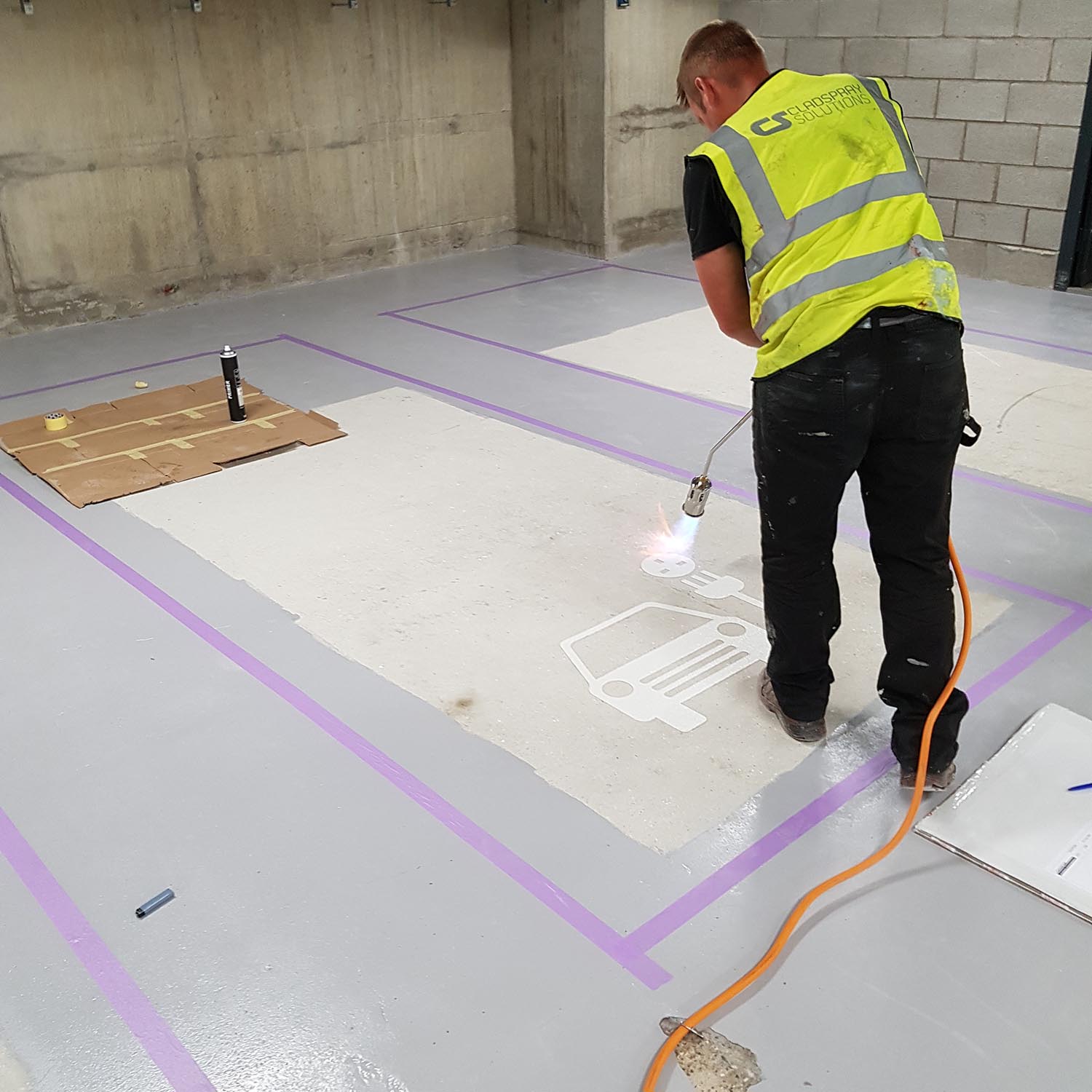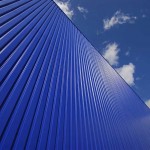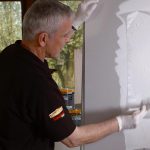Getting to grips with floor coating projects
 James Burton of leading coatings manufacturer, Bradite examines what is involved when undertaking the painting of both domestic and industrial flooring.
James Burton of leading coatings manufacturer, Bradite examines what is involved when undertaking the painting of both domestic and industrial flooring.
Whether you’re painting flooring in a domestic setting, a warehouse, a workshop, a school or hospital kitchen, an underground car park or something a little more challenging like an aircraft hangar or helipad, site preparation and product selection are the keys to success.
It is important to remember that not all floor paints are the same. Generic products include alkyds, polyeurethanes, epoxies, single pack, twin pack, water-based, solvent-free, moisture cure, chlorinated rubber and more. They may be described as domestic, industrial, garage, hard wearing, tough and flexible. James provides his advice for selecting the correct product for the job:
For domestic use, you may require a quick drying, low odour product that is easy to apply such as a single pack, cross linking water-based paint. For a light industrial situation, the coating should be hard wearing, grease resistant and able to cope with light to medium traffic. A single pack polyurethane, or a water-based cross-linking product may work well.
For heavier traffic areas, such as a workshop floor where oil and grease are present, you could try a moisture cure, chlorinated rubber or twin pack epoxy. To achieve quick-drying and recoat times, try a water-based cross linking moisture cure or chlorinated rubber.
In a working environment, such as an area for food preparation, you should use an odour and solvent-free product. Consider water-based cross linking or twin pack water-based epoxies.
There are certain circumstances where the coating must resist specific chemicals. In these cases, identify the chemicals and check the coating suitability directly with the product manufacturer.
In settings where regular deep cleaning is required such as a brewery or kennels, consider chlorinated rubber or twin-pack epoxies.

Substrates
Whether it’s concrete, steel, timber, or something else, the substrate upon which the coating is to be applied is critical. When choosing a coating, consider whether the substrate is new or aged, inside or outside, or previously covered with a different coating.
New concrete should be left for a minimum of 30 days before painting to allow time for it to completely dry out. This can be checked by laying a rubber mat on the floor and leaving it overnight. When removed, if the floor is discoloured or condensation is still visible, then moisture is still present, and the floor should be left until fully cured.
New concrete should also be checked for laitance, a milky deposit on the surface usually caused by excess water in the mix. If painted, it could act as a crust and detach from the base causing premature failure of any coating. This can be removed by blasting or acid etching.
Power floated, shiny or unpainted nonporous concrete flooring should be thoroughly blast cleaned, ground, acid etched or primed using an adhesion promoting floor primer before applying floor paint. The correct application of screeds is important so check with the manufacturer to ensure the screed is suitable for overcoating.
The correct preparation of steel substrate depends on whether it is ferrous or non-ferrous. Remove corrosion to brighten the steel, treating any stubborn spots or marks with rust converter before applying a primer. If previously painted, all coatings must be well adhered.
Turning to timber, softwood knots should be wiped and sealed using knotting compound or aluminium primer. Resinous hardwoods should be wiped with methylated spirits prior to priming with aluminium wood primer. The moisture content of the timber should be below 15%. Damp wood should never be painted as this will give rise to blistering, flaking and cracking. Damaged, rotten and darkened timber should be repaired prior to product application.
When covering previous and existing coatings, if possible, identify the existing product and check its compatibility with any new coatings. Existing coatings should be well adhered to. Any flaking, damaged or loose material should be removed back to a firm edge. Substrates should be clean, free of oil, grease and dust and completely dry before application of any product.
Preparation
Clean with high pressure wash and sweep to remove all loose debris. Degrease using an industrial degreaser and rinse. Lightly abrade the surface, blast or acid etch, vacuum to remove all dust and ensure the substrate is completely dry prior to application of the new coating. With power floated floors, once the surface is cleaned, they can be prepared by vacuum blast, grinding or diamond grinding, acid etching or the use of adhesion primers.
Application
With product selection and preparation now complete, we can move on to application. The method of application will depend on the product selected and the manufacturer’s instructions. As with any application, it is important to understand the product’s recoat, drying, and curing times. This information may be found on data sheets or provided by the product manufacturer.
Remember, most manufacturers will offer on-site and specification help. The old adage holds good: failure to prepare is preparing to fail!
[toggle title=”Bradite Product Guide” load=”hide”]Bradite TD39 Industrial Degreaser should be used on all types of floors, this is a concentrated water based economical cleaner and should be diluted with 9 parts of clean warm water prior to use, rinsed with clean water and allowed to dry. On heavily contaminated floors a second application may be necessary.
Bradite TA37 Acid Etch is a mineral acid solution used as a pre-treatment for bare concrete surfaces to remove excess lime and/or to etch a surface profile to smooth concrete, providing improved adhesion of subsequent floor coatings. Apply evenly with using soft brush and allow approximately 10 to 20 minutes to react. Two or more applications may be required depending upon the amount of laitance present. After the reaction has taken place the surface should be thoroughly rinsed with clean water to remove all loose particles and soluble salts. Rinsing should continue until surface shows a neutral or weakly alkaline pH when tested with litmus paper. Treated floor should then be allowed to thoroughly dry prior to vacuum cleaning to remove dust and all subsequent painting operations.
Bradite LS30 Low Slip Additive can be added to all Bradite Floor Paints to provide additional under foot traction. 250ml per 5lt.
Drying and curing times on all floor paints can be affected by temperature and over application, for best results good ventilation and air movement are important.
Hot Tyre pick up, on completion of new projects, always follow the minimum cure time guidelines and allow hot tyres to cool down before driving the vehicle onto the coating. If in doubt, please contact us for further advice.
Bradite Floor Paints are designed to be used without primers with first coat thinned on bare porous substrates to allow penetration. For non-porous concrete use of Bradite ES40 should replace thinned coat. Existing sound coatings application of two coats is recommended.
Which Floor Paint
Bradite DP5
Single pack Polyurethane Floor Paint. Interior or suitable exterior concrete, wood or steel floors requiring an economical, hard wearing, flexible floor coating with good chemical and excellent water resistance. Can be used with Bradite Low Slip Additive LS30 to provide additional under foot traction. Suitable for use over suitable prepared existing coatings including polyurethane and epoxies, not suitable for applying over asphalt, bitumen, epoxy tar, alkyd, chlorinated rubber or vinyl based paints. Light to medium traffic, touch dry 2 hours, recoat 16 hours, dry to take light traffic 24 hours after last coat. Light to medium domestic and industrial use. Easy to maintain and recoat. Brush, roller or spray application. External floor surfaces should be above local water table and/or have intact DPM barrier present. Compatibility with existing coatings should be confirmed by preparing and painting a test patch.
Bradite DP9 Floor-it
Cross linking water based, low odour, interior and exterior floor coating, for use on concrete, steel and other absorbent mineral substrates resistant to diesel, motor oil, coolant fluid, various household chemicals and most types of tyres. Can be used with Bradite Low Slip Additive LS30 to provide additional under foot traction. Suitable for application over suitably prepared existing coatings including polyurethane, epoxies and chlorinated rubber. Tough, hardwearing with abrasion test of 10,000 cycles showing little to no loss of film build, Recoat in 1 hour, low odour, light traffic 16 hours after last coat. Light to medium industrial use, occasional fork lift traffic. Easy to maintain and recoat. Brush, roller or spray application, non yellowing. External floor surfaces should be above local water table and/or have intact DPM barrier present. Compatibility with existing coatings should be confirmed by preparing and painting a test patch.
Bradite PW74 Rapid
Interior concrete, wood or steel floors requiring a tough, quick drying, hard wearing flexible floor coating with good chemical and excellent water resistance. Can be used with Bradite Low Slip Additive LS30 to provide additional under foot traction. Suitable for application over suitable prepared existing coatings including polyurethane and epoxies, not suitable for applying over asphalt, bitumen, epoxy tar, alkyd, chlorinated rubber or vinyl based paints. Recoat after 8 hours with maximum overcoat time of 16 hours, light traffic 24 hours after last coat. Be aware that hot high performance or new tyres may cause slight discolouration of very new coatings at the point of contact. This effect is very rare but may be noticeable in light colours and is due to the migration of rubber compounding materials into the surface of the coating. As with all aromatic moisture cure prepolymers, direct exposure to sunlight will cause yellowing. This effect will be most noticeable in light colours and the degree of yellowing will be in proportion to the amount of direct sunlight exposure. This product is intended for professional use only. Brush or roller application, do not spray. All traffic regular fork lift and heavy vehicle use.
Bradite CF22 Chlorinated Rubber
A quick drying Interior or exterior floor paint with excellent water and good chemical and urine resistance, for use on concrete and steel floors subject to water imersion. Can be used with Bradite Low Slip Additive LS30 to provide additional under foot traction. Compatibility with existing coatings should be confirmed by preparing and painting a test patch, suitable for use over suitable prepared epoxies. Touch dry 1 hour, recoat 12 hours. Heavy traffic after 24 hours. Brush, roller or spray application. For use at low temperature. External floor surfaces should be above local water table and/or have intact DPM barrier present. All traffic regular fork lift and heavy vehicle use.
Bradite EW99 H D Floor and Wall Coating
Twin pack water based low odour epoxy coating for interior concrete, wood or steel floors requiring a tough, quick drying, hard wearing flexible floor coating with good chemical and excellent water resistance. Can be used with Bradite Low Slip Additive LS30 to provide additional under foot traction. Compatibility with existing coatings should be confirmed by preparing and painting a test patch, not suitable for applying over asphalt, bitumen, epoxy tar, alkyd, chlorinated rubber or vinyl based paints. Hard wearing twin pack epoxy suitable for use in hygiene, deep clean areas with little or no odour during application. High gloss tough finish resistant to mould and bacterial growth. Touch dry 3 hours, recoat 14 hours. All traffic regular fork lift and heavy vehicle use.
Bradite EC88 Floor Coating
Twin pack solvent based epoxy coating for interior concrete, wood or steel floors requiring a tough, quick drying, hard wearing flexible floor coating with good chemical and excellent water resistance. Can be used with Bradite Low Slip Additive LS30 to provide additional under foot traction. This product is ideally suited for the refurbishment of fibreglass swimming pools, having excellent water immersion resistance, good chemical resistance and produces a surface that is easy to clean. Compatibility with existing coatings should be confirmed by preparing and painting a test patch, not suitable for applying over asphalt, bitumen, epoxy tar, alkyd, chlorinated rubber or vinyl based paints. Touch dry 3 hours, recoat 14 hours. All traffic regular fork lift and heavy vehicle use.
Bradite CR27 Roadline Paint
A quick drying universal line marking paint for use on roads, runways, car parks and sports facilities. Can be used with Bradite Low Slip Additive LS30 to provide additional under foot traction. Reflectivity can be achieved by using proprietary glass beads. For internal & external suitable prepared asphalt, steel, concrete and other absorbent mineral substrates. Compatibility with existing coatings should be confirmed by preparing and painting a test patch. Touch dry 10 minutes, recoat 1 hour. All traffic regular fork lift and heavy vehicle use.[/toggle]
Images used in the article were used with kind permission of cladspraysolutions.co.uk








